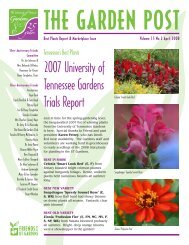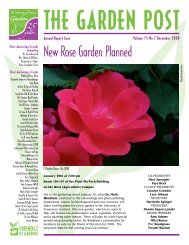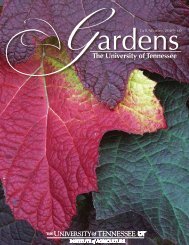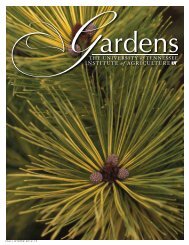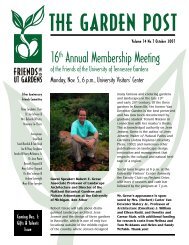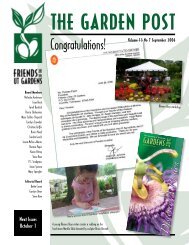May - UT Gardens - The University of Tennessee
May - UT Gardens - The University of Tennessee
May - UT Gardens - The University of Tennessee
Create successful ePaper yourself
Turn your PDF publications into a flip-book with our unique Google optimized e-Paper software.
From the <strong>UT</strong> <strong>Gardens</strong>’ CuratorJames NewburnElsewhere in this newsletter, Terumi Watsonwrites about this year’s Thomas Jefferson theme<strong>of</strong> our heirloom vegetable garden. I am also a bigfan <strong>of</strong> Mr. Jefferson and have also worked in hisvegetable garden and fruit orchard while studyingat Monticello. One <strong>of</strong> my favorite quotes fromJefferson is from a letter he wrote late in his lifeto portrait painter and naturalist Charles WillsonPeale in 1811: “Though an old man, I am but ayoung gardener.” Although I don’t think <strong>of</strong> myselfas an “old man” (yet) I do think <strong>of</strong> myself, evenafter 13 years <strong>of</strong> working in the <strong>UT</strong> <strong>Gardens</strong>, asa “young gardener,” because there are alwaysnew plants to discover and miracles <strong>of</strong> natureto behold. This month I would like to point outsome <strong>of</strong> the wonderful new plants that have beenadded to our collection and some others that havespecial distinctions.One <strong>of</strong> my new favorite trees is a variegated giantdogwood Cornus controversa ‘Variegata,’ orWedding Cake Tree. It is so named because <strong>of</strong> itswonderful horizontally tiered branching habit andits bright white variegation on green foliage. Asthe leaves unfurl in the spring, the creamy edgingmakes it appear this plant is flowering. However,those will come in late spring as clusters <strong>of</strong> smallwhite flowers. This is an ideal specimen plant andwill reach a height <strong>of</strong> 30-35’ with 30-40’ spread.It really makes a bright statement in the gardenand adds color and texture to the landscape. <strong>The</strong>distinctive layered branching even adds interest tothe winter landscape after the leaves have droppedand its bark is a rich dark color.I have also been so excited about a new additionto our conifer collection and cannot quit talkingabout it. Thuja orientalis ‘Van Hoey Smith’—VanHoey Smith Oriental Arborvitae—immediatelydraws your eye to it. You cannot miss this brilliantlygold variegated evergreen that is more goldthan green. This conifer has a somewhat looseupright growth habit and will reach a size <strong>of</strong> 8 feettall by 3 feet wide in about 10 years. Our specimencame from Gum Tree Nursery and is planted to theright <strong>of</strong> the entrance to the groundcover and arborgarden. But you can’t help but have this “24 carat”specimen catch your eye from many yards away.What a great plant for year round interest.Terumi Watson has not only taken on the heirloomvegetable garden but is also coordinating the maintenanceand refurbishing <strong>of</strong> our wonderful perennialborder. In April, Terumi and I went on a plantacquisition trip to several outstanding growingand breeding facilities, including MousecreekNursery near Riceville, Signal Mountain Nursery inChattanooga and Pike Nursery and Saul Nurseriesin the Atlanta area.Richard and Robert Saul and their partners arepremier plant breeders and have been responsiblefor bringing many new plant cultivars to themarket like ‘Sunrise’ and ‘Sunset’ Echinacea orConeflowers. Besides their perennials, they areknown for their tropical, succulent, ornamentalgrass and green ro<strong>of</strong> plant selections. Be sure andcheck out the new plants that we are evaluating inthe perennial border and throughout the <strong>Gardens</strong>in pocket beds to see the latest and soon to bereleased cultivars.Also in our perennial border and herb gardennotice the 2007 Perennial Plant <strong>of</strong> the Year, Nepetax faasenii ‘Walker’s Low’ or Walker’s Low Catmint.<strong>The</strong> name does not refer to the growth habit butis named for an Irish garden where it was discoveredin the 1970s. This plant can have stems thatget 2-3’ feet tall but will flop if not staked and forma lovely mounded mass. It is a prolific bloomerin early summer and is covered with beautifullavender-blue flowers for many weeks. In fact, afterits long bloom time, it can be sheared back andwill <strong>of</strong>ten bloom a second time. <strong>The</strong> s<strong>of</strong>t gray-bluegreen foliage is fragrant when crushed and attractscats much like its relative Nepeta cataria—the truecatnip. This plant is ideal for the foreground <strong>of</strong>the perennial border and to add even more to its



